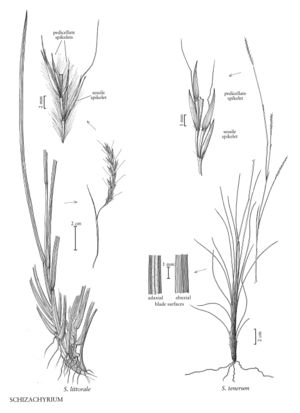Difference between revisions of "Schizachyrium tenerum"
FNA>Volume Importer |
imported>Volume Importer |
||
| (4 intermediate revisions by 2 users not shown) | |||
| Line 7: | Line 7: | ||
|synonyms={{Treatment/ID/Synonym | |synonyms={{Treatment/ID/Synonym | ||
|name=Andropogon tener | |name=Andropogon tener | ||
| − | |authority= | + | |authority= |
| + | |rank=species | ||
}} | }} | ||
|hierarchy=Poaceae;Poaceae subfam. Panicoideae;Poaceae tribe Andropogoneae;Schizachyrium;Schizachyrium tenerum | |hierarchy=Poaceae;Poaceae subfam. Panicoideae;Poaceae tribe Andropogoneae;Schizachyrium;Schizachyrium tenerum | ||
| Line 20: | Line 21: | ||
-->{{Treatment/Body | -->{{Treatment/Body | ||
|distribution=Puerto Rico;Okla.;Ga.;Tex.;La.;Ala.;Miss.;Fla. | |distribution=Puerto Rico;Okla.;Ga.;Tex.;La.;Ala.;Miss.;Fla. | ||
| − | |discussion=<p>Schizachyrium tenerum is an uncommon species in the southeastern United States, where it grows on sandy soils in pine forest openings and coastal prairies. Its range extends through Central America into South America.</p> | + | |discussion=<p><i>Schizachyrium tenerum</i> is an uncommon species in the southeastern United States, where it grows on sandy soils in pine forest openings and coastal prairies. Its range extends through Central America into South America.</p> |
|tables= | |tables= | ||
|references= | |references= | ||
| Line 29: | Line 30: | ||
-->{{#Taxon: | -->{{#Taxon: | ||
name=Schizachyrium tenerum | name=Schizachyrium tenerum | ||
| − | |||
|authority=Nees | |authority=Nees | ||
|rank=species | |rank=species | ||
| Line 37: | Line 37: | ||
|family=Poaceae | |family=Poaceae | ||
|illustrator=Linda A. Vorobik | |illustrator=Linda A. Vorobik | ||
| + | |illustration copyright=Utah State University | ||
|distribution=Puerto Rico;Okla.;Ga.;Tex.;La.;Ala.;Miss.;Fla. | |distribution=Puerto Rico;Okla.;Ga.;Tex.;La.;Ala.;Miss.;Fla. | ||
|reference=None | |reference=None | ||
| Line 42: | Line 43: | ||
|publication year= | |publication year= | ||
|special status= | |special status= | ||
| − | |source xml=https:// | + | |source xml=https://bitbucket.org/aafc-mbb/fna-data-curation/src/200273ad09963decb8fc72550212de541d86569d/coarse_grained_fna_xml/V25/V25_1618.xml |
|subfamily=Poaceae subfam. Panicoideae | |subfamily=Poaceae subfam. Panicoideae | ||
|tribe=Poaceae tribe Andropogoneae | |tribe=Poaceae tribe Andropogoneae | ||
Latest revision as of 18:57, 11 May 2021
Plants cespitose. Culms 60-100 cm, sometimes reclining or decumbent, glabrous. Collars not elongate, about as wide as the blade; ligules to 0.5 mm, ciliolate; blades 5-15 cm long, 0.5-2 mm wide, involute or flat, glabrous or sparsely hairy basally, with a wide central zone of bulliform cells evident on the adaxial surfaces as a longitudinal stripe of white, spongy tissue. Rames 2-6 cm, eventually long-exserted; internodes 2-4 mm, straight, glabrous. Sessile spikelets 3.5-4.5 mm; calluses 0.5-1 mm, hairs to 1.2 mm; lower glumes glabrous; upper lemmas acute, entire; awns 6-10 mm. Pedicels 3-5 mm, glabrous. Pedicellate spikelets usually as long as or slightly longer than the sessile spikelets, sterile, unawned. 2n = 60.
Distribution
Puerto Rico, Okla., Ga., Tex., La., Ala., Miss., Fla.
Discussion
Schizachyrium tenerum is an uncommon species in the southeastern United States, where it grows on sandy soils in pine forest openings and coastal prairies. Its range extends through Central America into South America.
Selected References
None.
